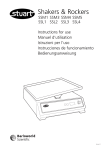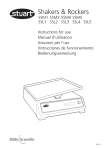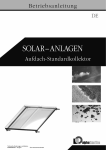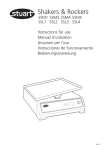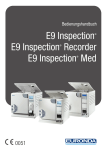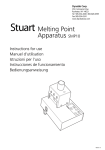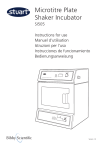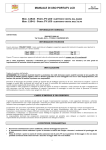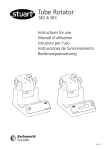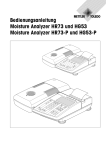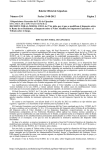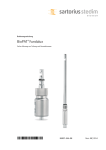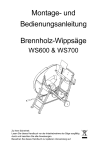Download Rockers & shakers manual
Transcript
Shakers & Rockers SSM1 SSM3 SSM4 SSM5 SSL1 SSL2 SSL3 SSL4 Instructions for use Manuel d’utilisation Istruzioni per l’uso Instrucciones de funcionamiento Bedienungsanweisung Version 1.0 English Rockers Sample tray (235 x 235mm) IEC connector Model: SSM3 & SSM4 IEC connector Digital control panel (see fig. 3) Sample tray (355 x 355mm) Model: SSL3 & SSL4 Digital control panel (see fig. 3) Figure 1 Shakers Sample tray (220 x 220mm) IEC connector Model: SSM1 & SSM5 Digital control panel (see fig. 3) Cradle system IEC connector Model: SSL1 & SSL2 Digital control panel (see fig. 3) Figure 2 1 SHAKERS & ROCKERS SSM1, SSM3, SSM4, SSM5, SSL1, SSL2, SSL3, SSL4 1. Introduction Thank you for purchasing this piece of Stuart equipment. To get the best performance from the equipment please read these instructions carefully before use. Before discarding the packaging check that all parts are present and correct. For your own safety and that of others please read and understand the safety advice given below before using the equipment. 2. Safety Advice before use If the equipment is not used in the manner described in this manual and with accessories other than those recommended by Barloworld Scientific the protection provided might be impaired. This equipment is designed to operate under the following conditions: ❖ ❖ ❖ ❖ ❖ ❖ ❖ ❖ ❖ For indoor use only Use in a well ventilated area Ambient temperature range +5°C to +40°C Altitude to 2000m Relative humidity not exceeding 80% Mains supply fluctuation not exceeding 10% Over-voltage category II IEC60364-4-443 Pollution degree 2 Use with a minimum distance all around of 200mm from walls or other items The unit should be carried using both hands. Do not use in a hazardous atmospheres or with hazardous materials. Ensure that the load is balanced. Do not attempt to stop movement by hand. Never move or carry the unit when in use or connected to the mains electricity supply. 2 In the case of mains interruption, the unit will not restart on restoration of the electricity supply. In the case of mechanical interruption, (e.g. motor stall), the unit will continue operating on removal of interruption. Mechanical energy can lead to breakage of glass vessels. Use with care. Mechanical hazard SSL2. Cradle to be assembled onto platform before operating. 3. General Description Stuart shakers and rockers are ideal instruments for mixing and aerating various biological and chemical samples in the laboratory. All models have digital setting of both speed and time up to 999 minutes. The SSM range comprise of personal units with a small footprint while the SSL is the larger labscale equivalent. Model SSM1 and SSL1 provides a smooth uniform circular motion with an orbit of 16mm. Speed range is 30 to 300rpm. Max load 3kg and 10kg respectively. Model SSL2 has a side-to-side reciprocating action ideal for vigorous shaking applications. Speed range is 25 to 250rpm. Max load 10kg*. IMPORTANT * Maximum speed with 10kg load is 200rpm. Maximum load for a speed setting of 250rpm is 5kg. Model SSM3 and SSL3 provides a 3D gyratory motion, ideal for low foaming agitation, DNA extractions, staining and de-staining procedures etc. Speed range is 5 to 70 rpm. Max load 3kg and 10kg respectively. The angle of tilt can be adjusted manually, without the need for tools, between 3 and 12° (see section 4.6 for instructions). Model SSM4 and SSL4 have a see-saw rocking action that creates a wave motion within vessels such as culture flasks, Petri dishes etc. Speed range is 5 to 70 rpm. Max load 3kg and 10kg respectively. Model SSM5 is designed for use with microtitre plates and microcentrifuge tubes. High speed combined with a tiny orbit creates the vibrational shaking action required for mixing very small volumes. Speed range is 250 to 1,200 rpm. IMPORTANT Maximum load is 1kg. 4. Preparation for Use – All models 4.1 Electrical Installation THIS INSTRUMENT MUST BE EARTHED Before connection please read and understand these instructions and ensure that the line supply corresponds to that shown on the rating plate. All models are designed for use on 230V 50Hz. The power consumption of each unit is 50W. The instruments are fitted with an IEC socket at the rear of the instrument for connection of the mains lead. Caution: Fuses fitted in both live and neutral lines. These units are supplied with two mains leads fitted with IEC plugs for connection to the instrument. One lead has a U.K. 3 pin plug and the other has a 2-pin “Shuko” plug for connection to the mains. Choose the lead appropriate for your electrical installation and discard the other. Should neither lead be suitable, take the lead with the U.K. plug and replace the plug with a suitable alternative. This involves cutting off the moulded plug, preparing the cable and connecting to the rewireable plug in accordance with its instructions. The wires in the mains cable are coloured as follows: LIVE - BROWN NEUTRAL - BLUE EARTH - GREEN/YELLOW The appropriate mains lead should be connected to the instrument BEFORE connection to the mains supply. Should the mains lead need replacement a cable of 1mm2 of harmonised code H05VV-F connected to an IEC320 plug should be used. N.B. The U.K. mains lead is protected by a 10A fuse mounted in the plug top. IF IN DOUBT CONSULT A QUALIFIED ELECTRICIAN 4.2 Connect to the electricity supply – DO NOT SWITCH ON. 4.3 Place the unit on a firm level non slip surface ensuring that there is sufficient free space on all sides to allow movement without coming into contact with anything during use. 4.4 Assemble cradle and rollers onto platform where applicable (ie SSL1, SSM1 with SSM1/1 & SSL2), making sure that the thumb screws have been tightened prior to operation. 4.5 Load the shaker/rocker with samples ensuring that the load is evenly balanced and does not exceed the maximum load stated. 4.6 Adjusting the angle of tilt on the 3D gyratory motion rockers, models SSM3 and SSL3. Set the rocker to the minimum speed (5rpm). Underneath the platform you will see a cylindrical shaft with a nut on it, stop the rocker when the nut faces you. Do not loosen the nut. The platform can now be tilted at right angles to the front fascia. Once you are happy with the angle of tilt restart the rocker. IT IS IMPORTANT THAT THIS OPERATION SHOULD ONLY BE UNDERTAKEN BY A QUALIFIED ELECTRICIAN NOTE: Refer to the equipment’s rating plate to ensure that the plug and fusing are suitable for the voltage and wattage stated. 3 5. Operation 5.1 Setting the speed Start/stop button Mode button Control knob Red digital display Figure 3 Switch the unit ON by pressing the control knob in (see fig 3). The unit will carry out a self test routine and then the red display will show the last stored set speed (red dot in the display shows RPM is selected). This can be adjusted by turning the control knob. Once the correct speed is displayed press the start / stop button to begin motion. automatically halted and an alert will sound. Press the start / stop button to revert back to the last time and speed values set or select new values following instructions given above. The speed can be adjusted without halting the unit. To switch the unit OFF completely, press the control knob in. The display will show OFF. The unit can be halted at any time by pressing the start / stop button. 5.3 Saving speed/time values. 5.2 Setting the timer. In order to use the timer, halt rotation and press the mode button. The red dot on the display moves over to time. The display will show the last stored time in minutes. Select the desired count down time using the control knob. When the display shows the correct time in minutes, press the start / stop button to begin operating. During operation, motion can be paused at any time by pressing the start / stop button. If the button is pressed again, motion will start again and the timer will continue to count down. The timer can be adjusted without halting the unit. When the timer reaches zero, the unit will be 4 N.B To disable the timer and revert to continuous rotation, select - - - in the display during timer mode. In order to save a commonly used speed/time value, switch the unit ON by pressing the control knob in (see fig 3). Select both a speed value and a time value (either 1 to 999 minutes, or continuous - - -) using the instruction given above. Switch the unit OFF by pressing in the control knob. Wait 5 seconds and switch the unit back ON by pressing the control knob in. The input values are now saved in memory. They can be altered at any time by following the same procedure. N.B. When the unit is switched OFF using the control knob, whatever values of speed/time were set prior to turning the unit off will be saved, and will be the values restored when the unit is switched back on. 6. Maintenance, Servicing & Repair WARNING: Ensure the unit is disconnected from the mains electricity supply before attempting maintenance or servicing. This range of equipment does not require routine servicing. The only maintenance required is to clean external surfaces with a damp cloth and mild detergent. Spillages or splashes should be cleaned up straightaway after isolating the unit from the mains electricity supply. 6.1 Repairs Any repairs or replacement of parts MUST be undertaken by suitably qualified personnel. Only spare parts supplied or specified by Barloworld Scientific Ltd. or its agent should be used. Fitting of non-approved parts may affect the performance of the safety features designed into the instrument. 7. Warranty Barloworld Scientific Ltd warrants this instrument to be free from defects in material and workmanship, when used under normal laboratory conditions, for a period of two (2) years. In the event of a justified claim, Barloworld Scientific will replace any defective component or replace the unit free of charge. This warranty does NOT apply if damage is caused by fire, accident, misuse, neglect, incorrect adjustment or repair, damage caused by installation, adaptation, modification, fitting of non-approved parts or repair by unauthorized personnel. Barloworld Scientific Ltd. Stone, Staffordshire ST15 0SA United Kingdom Tel: +44 (0) 1785 812121 Fax: +44 (0) 1785 813748 e-mail [email protected] www.barloworld-scientific.com For a comprehensive list of parts required by service engineers conducting internal repairs, or to receive a service manual, please contact the Sales Department of Barloworld Scientific Ltd quoting both the model and serial number. If in any doubt please contact the Technical Department of Barloworld Scientific Ltd. 6.2 Accessories Code Description SSM5/1 Tube holder for 1.5ml tubes SSM5/2 Tube holder for 0.5ml tubes SSM3/1 Tier system (for mini rockers) SSL3/1 Tier system (for large rockers) SSM1/1 Cradle system (for SSM1) SSM1/2 Large platform (for 8 well plates) for SSM1 SSM1/3 Plastic lid (for SSM1) SSL1/1 Large platform, 510 x 510mm 5 Français Agitateurs 3D & à bascule Plate-forme (235 x 235mm) Prise alimentation Modèles: SSM3 & SSM4 Prise alimentation Face avant (voir fig. 3) Plate-forme (355 x 355mm) Modèles: SSL3 & SSL4 Face avant (voir fig. 3) Figure 1 6 Agitateurs orbitaux Plate-forme (220 x 220mm) Prise alimentation Modèles: SSM1 & SSM5 Face avant (voir fig. 3) Plate-forme de maintien Prise alimentation Modèles: SSL1 & SSL2 Face avant (voir fig. 3) Figure 2 7 AGITATEURS 3D, 2D OU ORBITAUX SSM1, SSM3, SSM4, SSM5, SSL1, SSL2, SSL3, SSL4 1. Introduction Tout d’abord, nous vous remercions d’avoir choisi un appareil Stuart. Pour en tirer le meilleur parti, nous vous demandons de lire attentivement les instructions d’utilisations ci-dessous. Avant de jeter l’emballage, vérifiez bien de ne rien avoir oublié dedans et que toutes les pièces sont bien présentes. Pour votre sécurité et celle des autres, veuillez lire attentivement les consignes de sécurité ci-dessous avant d’utiliser l’appareil. 2. Conseils de sécurité avant utilisation Si cet appareil n’est pas utilisé de la façon décrite dans ce manuel et avec les accessoires Stuart recommandé par la Sté BIBBY STERILIN FRANCE, vous risquez de l’endommager et BIBBY STERILIN FRANCE décline toute responsabilité. Cet appareil a été conçu pour fonctionner dans les conditions suivantes : ❖ Utilisation en intérieur uniquement ❖ A utiliser dans une pièce correctement ventilée ❖ Température de fonctionnement comprise entre +5°C et +40°C ❖ Altitude inférieure à 2000m ❖ Humidité relative < 80% ❖ Fluctuation de l’alimentation électrique < 10% ❖ Catégorie de sur-voltage II IEC60364-4-443 ❖ Degré de pollution 2 ❖ Placer l’appareil sur une paillasse de taille suffisante avec, au minimum 200 mm d’espace libre autour de l’appareil 8 L’appareil doit être déplacer avec les deux mains. Ne pas utiliser avec des produits ou dans une atmosphère dangereux. Vérifier que la charge est uniformément répartie sur la plate-forme. Ne pas arrêter le mouvement avec les mains. Ne jamais déplacer l’appareil durant son utilisation ou connecté à l’alimentation électrique. En cas de coupure d’électricité l’appareil ne recommencera pas à fonctionner tout seul une fois le courant rétabli. En cas d’arrêt mécanique de l’appareil (point mort du moteur) l’agitation repartira dès la fin de l’interruption. Une agitation trop forte et non adapté à l’utilisation risque de cassé la verrerie utilisée ou de faire déborder les contenants. Régler la vitesse en fonction de l’utilisation. Sur le modèle SSL2, s’assurer que la plate-forme est bien mise en place avant utilisation. 3. Description générale Les agitateurs Stuart sont parfaitement adaptés à l’agitation de produits chimiques ou biologiques dans tous les laboratoires. Tous les appareils sont équipés d’un affichage digital de la vitesse d’agitation et d’une minuterie électronique (jusqu’à 999 minutes). Les modèles SSM sont de taille “mini” pour des utilisations en petite série alors que les modèles SSL sont conçus pour de plus grandes utilisations. Les modèles SSM1 et SSL1 offrent une agitation circulaire (orbitale) douce avec une orbite de 16 mm. La vitesse d’agitation est comprise entre 30 et 300 tr/min. La charge maximum respective est de 3kg et 10kg. Le modèle SSL2 a une agitation va-etvient idéale pour une agitation vigoureuse. La vitesse d’agitation est comprise entre 25 et 250 tr/min. La charge maximum est de 10kg *. IMPORTANT * La vitesse maximum avec une charge de 10kg est de 200 tr/min. La charge maximum avec la vitesse maximum de 250 tr/min. est de 5kg. Les modèles SSM3 et SSL3 offrent une agitation 3D idéale pour les applications en biotechnologie. La vitesse d’agitation est comprise entre 5 et 70 tr/min. La charge maximum respective est de 3kg et 10kg. L’angle d’inclinaison est réglable sans outils entre 3 et 12° (voir section 4.6 pour les instructions). Les modèles SSM4 et SSL4 ont une agitation sous forme de bascule pour créer un mouvement de vague dans les flacons culture, boites de Petri, etc. La vitesse d’agitation est comprise entre 5 et 70 tr/min. La charge maximum respective est de 3kg et 10kg. Le modèle SSM5 est conçu pour l’agitation des plaques de micro-titration et des micro-tubes à centrifuger. Une vitesse d’agitation rapide associée à un faible orbite crée un mouvement idéal et vigoureux pour l’agitation de petits volumes. La vitesse d’agitation est comprise entre 250 et 1200 tr/min. IMPORTANT La charge maximum est de 1kg. 4. Installation tout modèle 4.1 Installation électrique CES APPAREILS DOIVENT ÊTRE RELIÉS À LA TERRE ! Avant utilisation, lire les instructions ci-dessous et s’assurer de la conformité de l’alimentation électrique par rapport à la plaque située à l’arrière de l’appareil. Tous les modèles sont fait pour fonctionner avec une alimentation de 230V / 50Hz. La puissance électrique est de 50W. Les appareils sont tous équipés d’une prise CEE à l’arrière, pour le raccordement à l’alimentation électrique. Attention! Il y a un fusible sur le neutre et un sur la phase. Ces appareils sont livrés avec deux câbles de raccordement. Un est spécial pour l’Angleterre (3 broches) et l’autre pour l’Europe (2 broches). Choisir le câble approprié en fonction du pays d’utilisation. Si aucune de ces deux prises ne conviennent, prendre le câble anglais, retirer la prise et la remplacer par une adéquate en respectant le câblage. CETTE OPÉRATION DOIT ÊTRE EFFECTUÉE PAR DU PERSONNEL QUALIFIÉ ! NOTE : Se référer à la plaque située à l’arrière de l’appareil pour s’assurer que le voltage et le fusible sont appropriés. Le câblage est le suivant : PHASE - MARRON NEUTRE - BLEU TERRE - VERT/JAUNE Le câble doit être raccordé à l’instrument avant d’être raccordé à l’alimentation électrique. Si le câble doit être remplacé, cela doit l’être par un câble de 3 x 1 mm2, norme H05VV-F se terminant par une prise IEC320. N.B. Le câble anglais est protégé par un fusible de 10A logé dans la prise. EN CAS DE DOUTE, CONSULTEZ UN ÉLECTRICIEN QUALIFIÉ ! 4.2 Raccorder l’appareil à l’alimentation électrique. Ne pas le mettre en marche. Placer l’appareil sur une paillasse solide et non glissante avec suffisamment d’espace autour de l’appareil pour qu’il ne tape pas sur quelque chose durant son fonctionnement. Assembler la plate-forme et les barres de maintien lorsque c’est le cas (SSL1, SSM1 avec SSM1/1 & SSL2), et s’assurer que les vis de maintien sont bien serrées avant tout démarrage. Placer les échantillons sur la plate-forme de façon à ce qu’ils soient répartis équitablement et que cela ne dépasse pas la charge maximum de l’appareil. 9 Ajuster l’angle d’agitation sur l’agitateur 3D (modèles SSM3 & SSL3). Mettre la vitesse d’agitation sur 5 tr/min. Dessous la plate-forme il y a un cylindre avec une noix de réglage, il faut arrêter l’agitation lorsque la noix est face à vous. Ne pas perdre la noix ! La plate-forme peut alors être ajustée à l’angle souhaité. Mettre ensuite l’appareil en marche, normalement. 5. Utilisation 5.1 Programmer la vitesse Mettre l’appareil en marche en appuyant sur le bouton adéquat (voir fig. 3). Un auto test se fait automatiquement et ensuite, la dernière vitesse programmée est affichée (le point rouge s’allume sous le pictogramme de l’agitation). Modifier la vitesse en tournant simplement le bouton de réglage pour avoir à l’affichage la vitesse désirée. Appuyer ensuite sur “Start/Stop” pour démarrer l’agitation. La vitesse peut alors être modifiée sans être obligé de stopper l’appareil. L’appareil peut être stopper à tout moment en appuyant sur le bouton “Start/Stop”. 5.2 Programmer le temps Pour programmer la minuterie, stopper l’appareil et appuyer sur le bouton “mode”. Le point rouge doit s’allumer sous le pictogramme de la Pictogramme agitation Bouton marché/arrêt de l’agitation 10 minuterie. C’est la dernière valeur programmée, en minutes, qui s’affiche. Programmer le temps de fonctionnement voulu à l’aide du bouton de réglage puis appuyer sur le bouton “Start/Stop”. Durant le fonctionnement, il est possible de mettre l’appareil en pause en appuyant sur le bouton “Start/Stop”. En appuyant de nouveau sur ce bouton, l’appareil se mettra en marche à nouveau et le décompte de temps reprendra là où il avait été arrêté. Le temps programmé peut être modifié à tout moment sans être obligé d’arrêter l’appareil. Lorsque le décompte de temps est terminé, l’appareil s’arrête automatiquement et un signal sonore est émis. Appuyer de nouveau sur le bouton “Start/Stop” pour revenir aux valeurs de temps et de vitesse précédemment programmées et recommencer l’agitation ou programmer de nouvelle valeur comme indiqué précédemment. N.B Pour invalider la minuterie et utiliser l’appareil en fonctionnement continu, programmer “- - -” à l’affichage en mode minuterie. Pour éteindre totalement l’appareil, appuyer sur le bouton de réglage rotatif de la vitesse et du temps. L’affichage s’éteindra. 5.3 Sauvegarde des valeurs Pictogramme minuterie Bouton mode Bouton de réglage et de mise sous/hors tension de l’appareil Affichage de la vitesse Figure 3 Pour sauvegarder les valeurs utilisées fréquemment (vitesse/temps), mettre l’appareil sous tension en appuyant sur le bouton de réglage (voir fig. 3). Programmer les valeurs de temps et de vitesse désirées en suivant les instructions citées cidessus. Eteindre l’appareil à l’aide du bouton de réglage. Attendre 5 secondes et mettre à nouveau l’appareil sous tension, toujours à l’aide du bouton de réglage. Les valeurs programmées sont dès lors sauvegardées. Elles peuvent être modifiées à tout moment en suivant les instructions citées précédemment. N.B. Le fait de tourner le bouton de réglage lorsque l’appareil est éteint, ne modifie en rien les valeurs programmées et mémorisées. 6. Entretien & réparation ATTENTION: S’assurer que l’appareil est déconnecté de l’alimentation électrique avant toute intervention sur l’appareil. Ce type d’appareil ne nécessite pas de maintenance régulière et/ou particulière. Seul un nettoyage régulier de l’appareil avec un chiffon propre et sans détergent spécifique peut s’avérer utile. Les débordements de produits doivent être essuyés immédiatement et ce après avoir débranché l’appareil de son alimentation électrique. 6.1 Réparation Toute intervention doit impérativement être faite part un technicien qualifié. Seules les pièces détachées recommandées par la Sté BIBBY STERILIN FRANCE doivent être utilisées. L’utilisation de pièces autres peut altérer les performances ou la sécurité de l’appareil et annulent la garantie. En cas de doute, contacter le service après-vente de BIBBY STERILIN FRANCE. 6.2 Accessoires Code Description SSM5/1 Support pour tubes de 1,5ml SSM5/2 Support pour tubes de 0,5ml SSM3/1 Etagères pour mini agitateurs SSL3/1 Etagères pour agitateurs grande taille SSM1/1 Plate-forme pour SSM1 SSM1/2 Plate-forme pour 8 plaques de micro titration pour SSM1 SSM1/3 Couvercle plexi pour SSM1 SSL1/1 Grande plate-forme pour SSL1, 510 x 510mm 7. Garantie Barloworld Scientific Ltd garanti cet instrument pour une utilisation normale de laboratoire pour une période de deux (2) ans. En cas de réclamation justifiée Barloworld Scientific Ltd remplacera les pièces défectueuses gratuitement. Cette garantie ne s’appliquera pas si les dommages sont causés par le feu, un accident, une adaptation, négligence ou problème occasionné par l’utilisateur ou une modification, ou utilisation de pièces non recommandées par BIBBY STERILIN Ltd ou intervention par du personnel non qualifié. Barloworld Scientific France SAS ZI du Rocher Vert - BP 79 77793 Nemours Cedex France Tél: +33 1 64 45 13 13 Fax: +33 1 64 45 13 00 e-mail: [email protected] En cas de besoin, contacter BIBBY STERILIN France pour recevoir le manuel de maintenance de l’appareil en indiquant le modèle et son n° de série. 11 Italiano Agitatori basculanti Vassoio campioni (235 x 235mm) Connettore IEC Modello: SSM3 e SSM4 Connettore IEC Pannello di controllo digitale (vedi fig. 3) Vassoio campioni (355 x 355mm) Modello: SSL3 e SSL4 Pannello di controllo digitale (vedi fig. 3) Figura 1 12 Scuotitori/Shakers Vassoio campioni (220 x 220mm) Connettore IEC Modello: SSM1 e SSM5 Pannello di controllo digitale (vedi fig. 3) Supporto a rulli Connettore IEC Modello: SSL1 e SSL2 Pannello di controllo digitale (vedi fig. 3) Figura 2 13 SCUOTITORI E AGITATORI BASCULANTI SSM1, SSM3, SSM4, SSM5 SSL1, SSL2, SSL3, SSL4 1. Introduzione Congratulazioni per la scelta di questo apparecchio Stuart. Per ottenere le migliori prestazioni da questo apparecchio, si consiglia di leggere attentamente le istruzioni prima dell'uso. Prima di smaltire l'imballaggio, assicurarsi che tutte le parti siano presenti e siano corrette. Per la vostra sicurezza e per la sicurezza degli altri, leggere con attenzione i seguenti avvertimenti di sicurezza prima di utilizzare l'apparecchio. 2. Avvertimenti di sicurezza prima dell'uso L'utilizzo dell'apparecchio in maniere diverse da quelle descritte nel presente manuale e con accessori diversi da quelli raccomandati da Barloworld Scientific può compromettere le misure di protezione adottate. Questo prodotto è stato progettato per operare nelle seguenti condizioni: Da utilizzare soltanto in ambienti chiusi Utilizzare in ambienti ben ventilati Temperatura ambiente da +5 °C a +40 °C Altitudine fino a 2000m Umidità relativa non superiore a 80% Oscillazioni di tensione di alimentazione non superiori a 10% ❖ Categoria di sovratensione II IEC60364-4-443 ❖ Grado di inquinamento 2 ❖ Utilizzare ad una distanza minima di 200 mm da pareti o altri oggetti su tutti i lati ❖ ❖ ❖ ❖ ❖ ❖ Trasportare l'apparecchio afferrandolo con entrambe le mani. Non utilizzare in atmosfera pericolosa o con materiali pericolosi. 14 Assicurarsi che il carico sia bilanciato correttamente. Non cercare di fermare il movimento dell'apparecchio con le mani. Non spostare o trasportare l'apparecchio se in uso o collegato alla rete di alimentazione elettrica. Dopo una caduta di tensione di rete, l'apparecchio non si riavvierà da solo al ripristino dell'alimentazione. In caso di interruzione meccanica (ad esempio stallo del motore), l'apparecchio riprenderà il funzionamento non appena l'ostacolo è rimosso. L'energia meccanica può causare la rottura di recipienti in vetro. Utilizzare con cautela. Pericolo meccanico SSL2. Montare il supporto a rulli sulla piattaforma prima di avviare l'apparecchio 3. Descrizione generale Gli scuotitori e gli agitatori Stuart rappresentano la scelta ideale per la miscela e l'aerazione di vari campioni biologici e chimici in laboratorio. Tutti i modelli sono dotati di regolazione digitale di velocità e tempo, fino a un massimo di 999 minuti. La gamma SSM comprende apparecchi personali di dimensioni ridotte, mentre la gamma SSL comprende apparecchi omologhi, ma di maggiori dimensioni per uso generale in laboratorio. I modelli SSM1 e SSL1 offrono un movimento circolare uniforme e senza scosse con orbita di 16 mm. Gamma di velocità da 30 a 300 g/min. Carico massimo 3 kg e 10 kg rispettivamente. Il modello SSL2 offre un movimento alternativo laterale ideale per applicazioni in cui è necessaria un'agitazione energica. Gamma di velocità da 25 a 250 g/min. Carico max: 10 kg* IMPORTANTE: * La velocità massima consentita con carico 10 Kg è 200 g/min. Il carico massimo consentito a velocità 250 g/min è 5 kg. I modelli SSM3 e SSL3 offrono un movimento giratorio tridimensionale ideale per agitazione a bassa formazione, estrazione DNA, procedimenti di colorazione e decolorazione, ecc. Gamma di velocità da 5 a 70 g/min. Carico massimo 3 kg e 10 kg rispettivamente. L'angolo di inclinazione può essere regolato manualmente, senza l'uso di attrezzi, fra 3° e 12° (per istruzioni fare riferimento alla sezione 4.6). I modelli SSM4 e SSL4 offrono un movimento oscillante per la creazione di un moto ondulatorio all'interno di recipienti quali beute per culture, piastre di Petri, ecc. Gamma di velocità da 5 a 70 g/min. Carico massimo 3 kg e 10 kg rispettivamente. Il modello SSM5 è progettato per l'utilizzo con piastre per microtitolazione e tubi per microcentrifuga. L'alta velocità, abbinata a un'orbita molto ridotta, crea l'azione vibratoria di agitazione necessaria per miscelare volumi molto piccoli. Gamma di velocità da 250 a 1.200 g/min. IMPORTANTE Carico massimo: 1kg 4. Preparazione per l'uso tutti i modelli 4.1 Installazione elettrica QUESTA APPARECCHIATURA DEVE ESSERE COLLEGATA A TERRA Prima di procedere con il collegamento, leggere e capire le seguenti istruzioni e verificare che l'alimentazione elettrica di rete corrisponda ai valori prescritti nella targhetta dati dell'apparecchio. Tutti i modelli sono progettati per il funzionamento a 230V 50Hz. Il consumo di potenza di ciascun apparecchio è 50 W. Tutti gli strumenti sono dotati di un connettore IEC sul retro dell'apparecchio per il collegamento al cavo di alimentazione di rete. Attenzione: sono presenti fusibili sia sulla fase che sul neutro. Questi apparecchi sono forniti con due cavi per il collegamento all'alimentazione di rete, dotati di spine a norma IEC. Un cavo è dotato di spina GB a 3 spinotti e l'altro è dotato di una spina a 2 spinotti di tipo Shuko, per il collegamento all'alimentazione di rete. Scegliere il cavo adatto alla propria situazione e smaltire l'altro cavo. Se nessuno dei due cavi è adatto, sostituire la spina sul cavo di tipo britannico con una spina adatta alle proprie esigenze. Per effettuare questa operazione, tagliare la spina pressofusa, preparare il cavo e collegarlo ad una spina adatta secondo le istruzioni eventualmente fornite con la spina. TALE OPERAZIONE DEVE ESSERE ESEGUITA UNICAMENTE DA UN ELETTRICISTA QUALIFICATO. NOTA: Fare riferimento alla targhetta dati dell'apparecchio per verificare che la spina e il fusibile siano adatti alla tensione e alla potenza indicate. I singoli conduttori all'interno del cavo sono colorati come segue: FASE - MARRONE NEUTRO - BLU TERRA - VERDE/GIALLO Collegare sempre il cavo di alimentazione all'apparecchio PRIMA di inserire la spina nella presa di corrente di rete. Nel caso ne sia necessaria la sostituzione, utilizzare cavo da 1 mm2 codice armonizzato H05VV-F con una spina IEC320. N.B. Nel Regno Unito, la spina di alimentazione è protetta con un fusibile da 10A, montato all'interno della spina stessa. IN CASO DI DUBBI, RIVOLGERSI A UN ELETTRICISTA QUALIFICATO 4.2 Collegare l'apparecchio all'alimentazione elettrica - NON ACCENDERE L'APPARECCHIO. 4.3 Collocare l'apparecchio su di un piano orizzontale, solido e non sdrucciolevole, assicurandosi che vi sia spazio sufficiente intorno all'apparecchio per consentirne il movimento senza interferenze con altri oggetti. 15 4.4 Montare eventualmente supporto e rulli sulla piattaforma (es. modelli SSL1, SSM1 con SSM1/1 e SSL2), assicurandosi di stringere bene le viti a mano prima di avviare l'apparecchio. 4.5 Caricare l'apparecchio con i campioni, assicurandosi che il carico sia correttamente bilanciato e non superi il valore massimo consentito. 4.6 Regolazione dell'angolo di inclinazione sugli agitatori a movimento giratorio tridimensionale modelli SSM3 e SSL3. Impostare l'agitatore alla minima velocità (5 movimenti/min). Sotto alla piattaforma è visibile un perno cilindrico con un dado. Arrestare l'agitatore quando il dado si trova di fronte all'operatore. Non allentare il dado. È possibile ora inclinare la piattaforma in direzione perpendicolare al pannello anteriore dell'apparecchio. Dopo aver ottenuto l'inclinazione desiderata, riavviare l'apparecchio. avvio e arresto per avviare il movimento. È possibile regolare la velocità anche senza arrestare l'apparecchio. L'apparecchio può essere arrestato in qualsiasi momento premendo il pulsante "start/stop" di avvio e arresto. 5.2 Impostazione del timer Per impostare il timer, arrestare l'apparecchio e premere il pulsante "mode" di selezione modalità. Il punto rosso del display si sposta sull'indicazione del tempo. Il display visualizza l'ultimo tempo impostato in minuti. Impostare il tempo desiderato mediante il comando di regolazione. Quando il display visualizza il tempo desiderato, premere il pulsante "start/stop" di avvio e arresto per avviare il movimento. L'apparecchio può essere arrestato in qualsiasi momento premendo il pulsante "start/stop" di avvio e arresto. Premere nuovamente il pulsante per riavviare il movimento e il timer. 5. Utilizzo 5.1 Impostazione della velocità Accendere l'unità premendo il comando di regolazione(v. Fig. 3). Dopo l'esecuzione di una serie di test di autodiagnostica, il display visualizza l'ultima velocità memorizzata. Il punto rosso visualizzato dal display indica che è selezionata la velocità (rpm). Impostare eventualmente la velocità desiderata ruotando il comando di regolazione. Quando è visualizzata la velocità desiderata, premere il pulsante di È possibile regolare il timer anche senza arrestare l'apparecchio. Quando il timer raggiunge lo zero, l'apparecchio si arresta ed emette un segnale acustico di avviso. Premere nuovamente il pulsante "start/stop" di avvio e arresto per ripristinare gli stessi valori di tempo e velocità, oppure impostare nuovi valori con la stessa procedura. Pulsante di selezione modalità Pulsante di avvio e arresto 16 Display digitale rosso Comando di regolazione Figura 3 Controllo digitale Nota: per disabilitare il timer e impostare l'apparecchio per l'azionamento continuato, selezionare - - - sul display mentre in modalità Timer. Per spegnere l'apparecchio completamente, premere il comando di regolazione. Il display visualizzerà il messaggio OFF. 5.3 Memorizzazione dei valori di velocità e tempo Per memorizzare una combinazione di valori di velocità e tempo frequentemente utilizzati, accendere l'apparecchio premendo il comando di regolazione (v. Fig. 3). Impostare un valore di velocità e un valore di tempo (da 1 a 999 minuti o funzionamento continuo - - -) mediante la procedura sopra descritta. Spegnere l'apparecchio premendo il comando di regolazione. Attendere 5 secondi e riaccendere l'apparecchio premendo nuovamente il comando di regolazione. I valori impostati sono adesso memorizzati nell'apparecchio. Tali valori possono essere modificati in qualsiasi momento ripetendo la stessa procedura. N.B. Quando l'apparecchio viene spento premendo il comando di regolazione, i valori di velocità e tempo impostati vengono sempre memorizzati e verranno ripristinati quando l'apparecchio viene riacceso. 6. Manutenzione, assistenza e riparazione AVVERTENZA: Assicurarsi che l'apparecchio sia scollegato dall'alimentazione elettrica prima di intraprendere qualsiasi operazione di manutenzione o assistenza. Questa serie di apparecchi non richiede particolari interventi di assistenza. L'unica manutenzione necessaria è la pulizia delle superfici esterne con un panno umido e un detergente non aggressivo. Eventuali versamenti e spruzzi dovranno essere immediatamente puliti, assicurandosi di scollegare sempre l'apparecchio dall'alimentazione elettrica. 6.1 Riparazioni Ogni riparazione o sostituzione di componenti DEVE obbligatoriamente essere effettuata da personale adeguatamente qualificato. Utilizzare unicamente parti di ricambio fornite o specificate da Barloworld Scientific Ltd. o suoi agenti. L'installazione di parti non approvate può compromettere il funzionamento adeguato delle funzioni di sicurezza previste nello strumento. Per un elenco completo delle parti di ricambio richieste dai tecnici di assistenza per la realizzazione di riparazioni interne, oppure per ricevere un manuale di assistenza, rivolgersi al Dipartimento commerciale di Barloworld Scientific Ltd. indicando modello e numero di serie. In caso di dubbi, rivolgersi al Dipartimento tecnico di Barloworld Scientific Ltd. 6.2 Accessori Codice Descrizione SSM5/1 Struttura porta provette per provette da 1,5 ml SSM5/2 Struttura porta provette per provette da 0,5 ml SSM3/1 Sistema a ripiani (per mini agitatori) SSL3/1 Sistema a ripiani (per agitatori grandi) SSM1/1 Supporto a rulli (per SSM1) SSM1/2 Piattaforma grande (per 8 piastre a pozzetti) per SSM1 SSM1/3 Coperchio in plastica (per SSM1) SSL1/1 Piattaforma grande, 510 x 510 mm 7. Garanzia Barloworld Scientific Ltd garantisce che questo strumento è esente da difetti di materiali e lavorazione, se usato in normali condizioni di laboratorio, per un periodo di due (2) anni. In caso di richiesta giustificata, Barloworld Scientific sostituirà qualsiasi componente difettoso o l'apparecchio gratuitamente. La presente garanzia NON si applica in caso di 17 danni causati da incendio, incidente, uso improprio, negligenza, regolazione o riparazione incorretta, danni causati da installazione, adattamento, modifica, installazione di parti non approvate o riparazione realizzate da personale non autorizzato. Barloworld Scientific Italia Srl Via Alcide de Gasperi 56 20077 Riozzo di Cerro al Lambro Milano Italia Tel: +39 (0)2 98230679 Fax: +39 (0)2 98230211 e-mail: [email protected] www.barloworld-scientific.it 18 ~ Espanol Basculador Bandeja de muestras (235 x 235mm) Connector IEC Modelos: SSM3 y SSM4 Connector IEC Panel de control digital (vea la figura 3) Bandeja de muestras (355 x 355mm) Modelos: SSL3 y SSL4 Panel de control digital (vea la figura 3) Figura 1 19 Agitadores Bandeja de muestras (220 x 220mm) Connector IEC Modelos: SSM1 y SSM5 Panel de control digital (vea la figura 3) Sistema de soporte Connector IEC Modelos: SSL1 y SSL2 Panel de control digital (vea la figura 3) Figura 2 20 AGITADORES Y BASCULADORES No deberá usarse en atmósferas peligrosas o con materiales peligrosos. SSM1, SSM3, SSM4, SSM5 SSL1, SSL2, SSL3, SSL4 No intente detener el movimiento con la mano. 1. Introducción Gracias por comprar este instrumento Stuart. Para obtener el mejor rendimiento del instrumento rogamos lea detenidamente estas instrucciones antes de utilizarlo. Asegure que el peso de la carga esté equilibrado. No mueva o transporte nunca el instrumento mientras lo utiliza ni lo conecte al suministro eléctrico de la red. Si se interrumpe el suministro de la red, el instrumento no volverá a reactivarse al restaurarse la corriente eléctrica. Antes de desechar el embalaje asegure que se incluyen todas las piezas y que están en buen estado. En caso de interrupción mecánica (e.g. si se cala el motor), el instrumento continuará funcionando al eliminarse la causa de la interrupción. Para seguridad propia y de otros por favor lea y memorice el consejo de seguridad descrito a continuación antes de utilizar el instrumento. La energía mecánica puede provocar la rotura de los recipientes de vidrio, de modo que debe utilizarse con precaución. 2. Consejo de seguridad antes de utilizar Si el instrumento no se utiliza de la manera descrita en este manual y se usa con accesorios que no son los recomendados por Barloworld Scientific podrá perjudicarse la eficacia de la protección ofrecida. Este instrumento ha sido diseñado para funcionar en las condiciones siguientes: ❖ Para uso interior solamente ❖ En un área bien ventilada ❖ A una temperatura ambiente entre +5°C y +40°C ❖ A una altitud de hasta 2000m ❖ A una humedad relativa no superior al 80% ❖ La fluctuación del suministro de la red no debe superar el 10% ❖ Sobrevoltaje de acuerdo con la categoría II IEC60364-4-443 ❖ Grado de polución 2 ❖ A una distancia de aproximadamente 200mm de paredes y otros elementos Peligro mecánico SSL2. El soporte debe montarse en la plataforma antes del funcionamiento. 3. Descripción general Los agitadores y basculadores Stuart son instrumentes ideales para la mezcla y aireación de diversas muestras biológicas y químicas en el laboratorio. Todos los modelos incorporan ajuste digital tanto de velocidad como de tiempo hasta 999 minutos. La gama SSM comprende instrumentos de uso personal con cobertura de instalación reducida mientras que los de la gama SSL son los equivalentes de mayor tamaño normalmente utilizados en el laboratorio. Los modelos SSM1 y SSL1 realizan un movimiento circular uniforme con una órbita de 16mm. Desarrollan velocidades de 30 a 300rpm con cargas máximas de 3kg y 10kg respectivamente. El modelo SSL2 efectúa un movimiento reciprocante de lado a lado ideal cuando se requiere un agitado enérgico. Velocidades de 25 a 250rpm con carga máximas de 10kg*. El instrumento deberá transportarse con ambas manos. 21 IMPORTANTE cada instrumento es de 50W. * La velocidad máxima con 10kg de carga son 200rpm. La carga máxima para una velocidad de 250rpm son 5kg. Los instrumentos incorporan una toma IEC en su parte posterior para la conexión del cable de la red. Los modelos SSM3 y SSL3 realizan un movimiento giratorio tridimensional ideal para un agitado de baja formación, extracciones de DNA, procedimientos de tinción y destinción, etc. Desarrollan velocidades de 5 a 70 rpm con cargas máximas de 3kg y 10kg respectivamente. El ángulo de inclinación puede ajustarse manualmente entre 3 y 12° sin necesidad de herramientas (vea las instrucciones en la sección 4.6). Los modelos SSM4 y SSL4 realizan un movimiento basculante de vaivén parecido al del oleaje en el interior de recipientes tales como matraces de cultivo, cajas Petri, etc. Desarrollan velocidades de 5 a 70 rpm con cargas máximas de 3kg y 10kg respectivamente. El modelo SSM5 está diseñado para ser usado con placas de microtitular y tubos de microcentrifugar. Su alta velocidad combinada con una diminuta órbita crea el agitado vibratorio requerido para el mezclado de volúmenes sumamente reducidos. Desarrollan velocidades de 250 a 1.200rpm. IMPORTANTE Carga máxima de 1kg. 4. Preparación para utilización - Todos los modelos 4.1 Instalación eléctrica ESTE INSTRUMENTO DEBE SER CONECTADO A MASA Antes de la conexión se ruega leer y memorizar estas instrucciones y asegurar que el suministro de la línea corresponde con el especificado en la placa de datos. Todos los modelos están diseñados para ser usados con 230V, 50Hz. El consumo eléctrico de 22 Precaución: Hay fusibles instalados tanto en el hilo activo como en el neutro. Todos los modelos se envían con dos cables de la red provistos de enchufes IEC para su conexión al instrumento. Un cable incorpora un enchufe de 3 clavijas U.K. y el otro con un enchufe de 2 clavijas "Shuko" para su conexión a la red. Seleccione el cable adecuado para su instalación eléctrica y deseche el otro. Si ninguno de los cables es adecuado, seleccione el cable con el enchufe U.K. y sustituye éste por otro alternativo adecuado. Esto requiere cortar el enchufe moldeado, preparar el cable y conectarlo al enchufe alternativo de acuerdo con las instrucciones. ES IMPORTANTE ASEGURAR QUE ESTA OPERACIÓN SEA REALIZADA SOLAMENTE POR UN ELECTRICISTA CUALIFICADO NOTA: Consulte la placa de datos del instrumento para asegurar que el enchufe y el fusible sean adecuados para el voltaje y vataje especificados en la placa. Los hilos incluidos en el cable de la red muestran los colores siguientes: ACTIVO - MARRÓN NEUTRO - AZUL TIERRA - VERDE / AMARILLO El cable de la red adecuado deberá ser conectado al instrumento ANTES de efectuar la conexión al suministro de la red. Si es necesario recambiar el cable de la red deberá emplearse un cable de 1mm2 de código armonizado H05VV-F conectado a un enchufe IEC320. N.B. El cable de la red U.K. está protegido con un fusible de 10A sobre el enchufe. EN CASO DE DUDAS CONSULTE CON UN ELECTRICISTA PROFESIONAL 4.2 Conecte el suministro eléctrico - NO TODAVÍA ACTIVE EL INSTRUMENTO. 4.3 Coloque el instrumento en superficie firme, nivelada y antideslizante, con suficiente espacio alrededor para moverse sin entrar en contacto con obstrucciones durante su utilización. 4.4 Instale el soporte en la plataforma si aplica (i.e. modelos SSL1, SSM1 con SSM1/1 y SSL2), asegurando que los tornillos mariposa estén apretados antes de encender el instrumento. 4.5 Disponga la muestra en el agitador / basculador asegurando que la carga permanezca uniformemente equilibrada y no exceda la carga máxima especificada. 4.6 Ajuste el ángulo de inclinación de los basculadores de movimiento giratorio tridimensional SSM3 y SSL3. Ponga el basculador a velocidad mínima (5rpm). Bajo la plataforma hay un eje cilíndrico con una tuerca; detenga el basculador cuando la tuerca quede orientada hacia usted. No afloje la tuerca. La plataforma podrá inclinarse ahora a ángulos rectos con su cara frontal. Una vez satisfecho con el ángulo de inclinación, vuelva a activar el basculador. 5. Funcionamiento 5.1 Ajuste de velocidad Encienda el instrumento pulsando la perilla de control (vea la figura 3). El instrumento realizará una prueba automática rutinaria tras lo cual la pantalla roja visualizará la última velocidad almacenada (el punto rojo en la pantalla muestra las RPM seleccionadas). Esto puede ajustarse girando perilla de control. Una vez visualizada la velocidad correcta, pulse el botón encender / apagar para iniciar el movimiento. La velocidad puede ser ajustada con el instrumento funcionando. El instrumento puede detenerse en cualquier momento pulsando el botón encender / apagar. 5.2 Ajuste del temporizador Para utilizar el temporizador, detenga la rotación y pulse el botón de modo. El punto rojo en la pantalla se mueve a tiempo. La pantalla visualizará el tiempo últimamente almacenado en minutos. Seleccione el tiempo de cuenta atrás requerido usando la perilla de control. Cuando la pantalla visualiza el tiempo correcto en minutos, pulse el botón encender / apagar para iniciar el funcionamiento. Durante el funcionamiento, el movimiento puede detenerse en cualquier momento pulsando el botón encender / apagar. Si el botón se pulsa de nuevo, el movimiento se reanudará y el temporizador continuará la cuenta atrás. El temporizador puede ser ajustado sin detener el instrumento. Cuando el temporizador llega a cero, el instrumento se detendrá automáticamente y se activará una señal de alarma audible. Pulse el Botón de modo Botón de encender/apagar Pantalla digital roja Perilla de control Figura 3 Controles digitales 23 botón encender / apagar para retroceder a los últimos valores de tiempo y velocidad ajustados o seleccione nuevos valores observando las instrucciones previamente descritas. trapo húmedo y un detergente suave. Los derrames y las salpicaduras deberán limpiarse inmediatamente de ocurrir después de aislar el instrumento de la red eléctrica. N.B. Para desactivar el temporizador y volver a la rotación continua, seleccione - - en la pantalla durante el modo temporizador. 6.1 Reparaciones Para apagar el instrumento por completo, pulse la perilla de control. La pantalla visualizará OFF (apagar). 5.3 Para guardar los valores de velocidad / tiempo Para guardar un valor normalmente usado de velocidad / tiempo, encienda el instrumento pulsando el perilla de control (vea la figura 3). Seleccione un valor de velocidad y un valor de tiempo (ya sea en 1 a 999 minutos, o bien de manera continua - - -) siguiendo la instrucción arriba descrita. Apague el instrumento pulsando la perilla de control. Espere 5 segundos y vuelva a encender el instrumento pulsando el perilla de control. Los valores introducidos quedan ahora guardados en la memoria. Podrán ser modificados en cualquier momento observando el mismo procedimiento anterior. N.B. Al apagar el instrumento con la perilla de control, todos los valores de velocidad / tiempo ajustados antes de apagar el instrumento serán guardados y los mismos serán restaurados cuando se vuelve a encender el instrumento. 6. Mantenimiento, servicio y reparación AVISO: Asegure que el instrumento sea desconectado de la red de suministro eléctrico antes de intentar realizar cualquier trabajo de mantenimiento o servicio. Los instrumentos de esta gama no requieren servicio rutinario alguno. El único mantenimiento que requieren es una limpieza exterior con un 24 Todas las reparaciones o recambios de piezas DEBEN ser realizados por personal adecuadamente cualificado. Solamente deberán utilizarse piezas de repuesto suministradas o especificadas por Barloworld Scientific Ltd. o por su agente autorizado. La instalación de piezas no aprobadas puede afectar la efectividad de las características de seguridad incorporadas en el instrumento. Si desea una lista completa de piezas requeridas por los técnicos de servicio que realizan las reparaciones internas, o recibir un manual de servicio, por favor póngase en contacto con el Departamento de Ventas de Barloworld Scientific Ltd especificando tanto el modelo como el número de serie del instrumento. Si tiene cualquier tipo de duda, por favor póngase en contacto con el Departamento Técnico de Barloworld Scientific Ltd. 6.2 Accesorios Código Descripción SSM5/1 Portatubos para tubos de 1,5ml SSM5/2 Portatubos para tubos de 0,5ml SSM3/1 Sistema de hileras (para basculadores miniatura) SSL3/1 Sistema de hileras (para basculadores grandes) SSM1/1 Sistema de soporte (para el modelo SSM1) SSM1/2 Plataforma grande (para placas de 8 huecos) para el modelo SSM1 SSM1/3 Tapa de plástico (para el modelo SSM1) SSL1/1 Plataforma grande de 510 x 510mm 7. Garantía Barloworld Scientific Ltd garantiza este instrumento libre de defectos en materiales y mano de obra, cuando se utiliza en condiciones de laboratorio normales, durante un periodo de dos (2) años. En caso de surgir una reclamación válida, Barloworld Scientific sustituirá gratuitamente cualquier componente defectuoso o el propio instrumento. Esta garantía NO aplica si el daño es causado por incendio, accidente, uso incorrecto, descuido, ajuste o reparación incorrectos, o daño causado por la instalación, adaptación, modificación, colocación de piezas no aprobadas o reparaciones realizadas por personal no autorizado. Afora S.A. Calle Aribau 240 08006 Barcelona Spain Tel: +343 93-306 98 00 Fax: +343 93-306 98 23 e-mail: [email protected] www.afora.com 25 Deutsch Wipptische Probenschale (235 x 235mm) IEC Netzstecker Modell: SSM3 & SSM4 IEC Netzstecker Digitalsteuerung (siehe Abb. 3) Probenschale (355 x 355mm) Modell: SSM3 & SSM4 Digitalsteuerung (siehe Abb. 3) Abbildung 1 26 Schüttler Probenschale (220 x 220mm) IEC Netzstecker Modell: SSM1 & SSM5 Digitalsteuerung (siehe Abb. 3) Gestellsystem IEC Netzstecker Modell: SSL1 & SSL2 Digitalsteuerung (siehe Abb. 3) Abbildung 2 27 SCHÜTTLER UND WIPPTISCHE SSM1, SSM3, SSM4, SSM5 SSL1, SSL2, SSL3, SSL4 1. Einleitung Wir bedanken uns für den Kauf dieses Stuart Produkts. Lesen Sie bitte vor dem Gebrauch diese Bedienungsanleitung gründlich durch, um das Gerät optimal nutzen zu können. Kontrollieren Sie bitte vor dem Entsorgen der Verpackung, ob alle Bestandteile des Geräts vorhanden sind. Die folgenden Sicherheitshinweise dienen Ihrer eigenen Sicherheit und der anderer Personen. Lesen Sie diese deshalb vor dem Einsatz des Geräts aufmerksam durch. 2. Vor dem Gebrauch zu beachtende Sicherheitshinweise Wenn das Gerät nicht entsprechend der Bedienungsanleitung betrieben, bzw. mit nicht von Barloworld Scientific empfohlenen Zubehörteilen eingesetzt wird, können die Schutzfunktionen des Gerätes beeinträchtigt werden. Dieses Gerät ist für den Einsatz unter folgenden Bedingungen ausgelegt: Nur für den Gebrauch in Innenräumen In einem gut durchlüfteten Bereich aufstellen Umgebungstemperatur +5°C bis +40°C Höhe: Bis zu 2000 m Relative Luftfeuchte nicht über 80% Netzspannungsschwankungen nicht über 10% ❖ Überspannungsklasse II IEC60364-4-443 ❖ Verschmutzungsgrad 2 ❖ Es ist ein Mindestabstand von 200 mm zu allen Wänden und anderen Gegenständen einzuhalten ❖ ❖ ❖ ❖ ❖ ❖ 28 Das Gerät muss mit beiden Händen getragen werden. Das Gerät nicht in explosionsfähigen Stoffen oder entzündlichen Atmosphären betreiben. Auf eine gleichmäßige Gewichtsverteilung achten. Die Bewegung nicht mit der Hand unterbrechen. Das Gerät niemals transportieren, wenn es in Betrieb, oder an die Stromversorgung angeschlossen ist. Bei einem Stromausfall schaltet sich das Gerät nach Beheben der Störung nicht wieder ein. Im Falle einer mechanischen Unterbrechung (z. B. Motor bleibt stehen) schaltet sich das Gerät nach Beheben der Störung wieder ein. Mechanische Energie kann zum Bruch von Glasgefäßen führen. Vorsichtig vorgehen. Mechanische Gefahr SSL2. Das Gestell vor dem Betrieb auf der Plattform aufbauen. 3. Allgemeine Beschreibung Die Schüttler und Wipptische von Stuart sind die idealen Geräte für das Mischen und Belüften verschiedener biologischer und chemischer Proben im Labor. Alle Modelle besitzen eine Digitaleinstellung der Geschwindigkeit und der Zeitdauer (bis zu 999 Minuten). Die SSM Serie besteht aus Geräten mit kleiner Aufstellfläche für den persönlichen Gebrauch, während die SSL Reihe für den Einsatz in großen Labors gedacht ist. Die Modelle SSM1 und SSL1 erzeugen eine gleichmäßige Kreisbewegung mit einem Orbit von 16 mm. Die Geschwindigkeit lässt sich von 30 bis 300 UPM einstellen. Die Höchstbelastbarkeit liegt bei 3 kg bzw. 10 kg. Das Modell SSL2 erzeugt eine Hin- und Herbewegung, die ein besonders starkes Schütteln ermöglicht. Die Geschwindigkeit ist zwischen 25 und 250 UPM einstellbar. Höchstbelastbarkeit: 10 kg*. ACHTUNG * Höchstgeschwindigkeit bei 10 kg Beladung: 200 UPM. Höchstbeladung bei Geschwindigkeitseinstellung auf 250 UPM: 5 kg. Die Modelle SSM3 und SSL3 erzeugen eine 3D Kreiselbewegung für Mischprozesse mit geringer Schaumbildung, für die DNA Extrahierung, für Färbungs-/Entfärbungsverfahren etc. Der Geschwindigkeitsbereich liegt zwischen 5 und 70 UPM. Die Höchstbeladung beträgt jeweils 3 kg bzw. 10 kg. Der Neigungswinkel kann ohne Zuhilfenahme von Werkzeug zwischen 3° und 12° eingestellt werden (Anweisungen hierzu finden Sie im Abschnitt 4.6). Die Modelle SSM4 und SSL4 eine Schaukelmischung um eine Wellenbewegung in Kulturgefäßen, Petrischalen usw. zu erzielen. Der Geschwindigkeitsbereich liegt zwischen 5 und 70 UPM. Die Höchstbeladung beträgt jeweils 3 kg bzw. 10 kg. Das Modell SSM5 ist für Mikrotiterplatten und Mikrozentrifugenröhrchen geeignet. Eine hohe Drehzahl in Verbindung mit einem sehr kurzen Umlauf erzeugt die zum Mischen von geringen Mengen erforderliche Vibrationsschüttlung. Der Geschwindigkeitsbereich liegt zwischen 250 und 1200 UPM. ACHTUNG Die Höchstbeladung beträgt 1 kg. 4. Vor dem Gebrauch - alle Modelle 4.1 Elektrischer Anschluss DIESES GERÄT MUSS GEERDET WERDEN Vor dem Anschließen bitte die Anleitung zunächst aufmerksam durchlesen. Darauf achten, dass die Stromversorgung den Angaben auf dem Typenschild entspricht. Alle Modelle müssen an 230V/50Hz angeschlossen werden. Die Leistungsaufnahme des Geräts beträgt 50 W. Auf der Geräterückseite befindet sich eine Europa-Steckdose für den Anschluss des Netzkabels. Vorsicht: Sowohl Phasen- als auch Nullleiter sind durch Sicherungen geschützt. Das Gerät wird mit zwei Netzkabeln mit unterschiedlichen Steckern geliefert. Das eine Kabel besitzt einen 3-poligen Stecker für Großbritannien, während das andere Kabel mit einem zweipoligen Schuko-Stecker ausgerüstet ist. Wählen Sie das für Ihren Standort geeignete Kabel und entsorgen Sie das andere. Sollten beide Kabel nicht passen, nehmen Sie bitte das Kabel mit dem GB-Stecker und schließen Sie den entsprechenden neuen Stecker an. Dazu muss der angespritzte Stecker abgeschnitten werden. Dann das Kabel für den neuen Stecker vorbereiten und diesen entsprechend den jeweiligen Anweisungen anschließen. WICHTIG: DIES DARF NUR VON EINEM ELEKTRO-FACHMANN AUSGEFÜHRT WERDEN HINWEIS: Beachten Sie das Typenschild des jeweiligen Geräts um sicher zu sein, dass Stecker und Sicherungen der entsprechenden Spannung und Wattleistung entsprechen. Farbkennzeichnung des Netzkabels: PHASENLEITER - BRAUN NULLLEITER - BLAU ERDLEITER - GRÜN/GELB Das entsprechende Kabel zuerst am Gerät einstecken BEVOR der Anschluss an die Stromversorgung erfolgt. Bei einem eventuellen Austausch des Netzkabels wird ein Kabel vom Typ H05VV-F mit 1 mm2 Adernquerschnitt und Europastecker (IEC 320) benötigt. Hinweis: Das GB-Netzkabel ist durch eine 10 A Sicherung im Stecker selbst geschützt. IM ZWEIFELSFALL EINEN ELEKTROFACHMANN HINZUZIEHEN 29 4.2 An die Stromversorgung anschließen NICHT EINSCHALTEN. 4.3 Das Gerät auf einer festen, ebenen, rutschfesten Fläche aufstellen. Auf ausreichenden seitlichen Freiraum achten, damit das Gerät im Betrieb nicht mit anderen Gegenständen kollidiert. 4.4 Falls zutreffend, Gestell und Rollen auf der Plattform aufbauen (d. h. SSL1, SSM1 mit SSM1/1 & SSL2). Darauf achten, dass die Flügelschrauben vor Inbetriebnahme festgezogen sind. 4.5 Den Schüttler/Wipptisch mit den Proben beladen. Auf gleichmäßige Gewichtsverteilung und Einhaltung der Höchstbelastbarkeit achten. 4.6 Bei den Modellen SSM3 und SSL3 mit 3D Kreiselbewegung den Neigungswinkel einstellen. Die Mindestgeschwindigkeit wählen (5 UPM). Unter der Plattform befindet sich eine zylindrische Welle mit aufgesetzter Mutter. Den Wipptisch anhalten sobald die Mutter aus Ihrer Position zu sehen ist. Diese Mutter nicht lösen. Die Plattform kann nun rechtwinklig zur Gerätevorderseite geneigt werden. Nach zufriedenstellender Einstellung des Winkels den Wipptisch erneut starten. 5. Bedienung Selbstprüfung aus. Anschließend zeigt das rote Display die zuletzt eingestellte Geschwindigkeit an (der rote Punkt im Display zeigt an, dass die Geschwindigkeitsfunktion "RPM" gewählt ist). Die Geschwindigkeit wird mit dem Regler eingestellt. Nach Einstellung der gewünschten Geschwindigkeit wird die Bewegung durch Drücken der Taste Start/Stop begonnen. Die Geschwindigkeit kann auch bei laufendem Gerät geregelt werden. Das Gerät kann jederzeit über die Start/Stop Taste angehalten werden. 5.2 Einstellen der Zeitautomatik Zur Einstellung der Zeitautomatik die Bewegung beenden und die Funktionstaste drücken. Der rote Punkt im Display wechselt auf das Zeitsymbol. Auf dem Display erscheint nun die zuletzt eingestellte Zeit (in Minuten). Wählen Sie die gewünschte Zeitdauer mit dem Regler. Sobald die richtige Zeit (in Minuten) eingestellt ist auf die Start/Stop Taste drücken um die Bewegung zu starten. Während des Betriebs kann die Bewegung jederzeit durch Drücken der Taste Start/Stop angehalten werden. Bei erneutem Drücken der Taste läuft die Bewegung wieder an und die Zeitautomatik läuft weiter. 5.1 Einstellung der Geschwindigkeit Der Timer kann auch bei laufendem Gerät eingestellt werden. Das Gerät durch Drücken des Reglers einschalten (siehe Abb. 3). Das Gerät führt nun eine Nachdem die Zeitautomatik auf Null heruntergezählt hat, hält das Gerät automatisch Funktionstaste Start/Stop Taste 30 Rote Digitalanzeige Regler Abbildung 3 Digitalsteuerung an und erzeugt ein akustisches Signal. Drücken Sie die Start/Stop Taste um zur letzten Zeiteinstellung zurückzukehren oder stellen Sie einen neuen Zeitwert ein (siehe oben). Hinweis: Um die Zeitautomatik zu deaktivieren (Dauerbetrieb) wählen Sie die Einstellung - - - auf dem Timer-Display. Auf den Regler drücken, um das Gerät ganz auszuschalten. Auf dem Display erscheint OFF. 5.3 Speichern der Geschwindigkeits/Zeiteinstellungen Um eine oft verwendete Geschwindigkeits/Zeiteinstellung zu speichern, drücken Sie auf den Regler um das Gerät einzuschalten (siehe Abb. 3). Wählen Sie entsprechend der obigen Anleitung Werte für die Geschwindigkeit und die Zeitautomatik (entweder 1 bis 999 Minuten, oder Dauerbetrieb - - -). Schalten Sie nun das Gerät durch erneutes Drücken auf den Regler aus. Warten Sie 5 Sekunden und schalten Sie dann das Gerät durch Drücken des Reglers wieder ein. Die eingegebenen Werte sind nun gespeichert und können jederzeit mit dem gleichen Verfahren verändert werden. Hinweis: Wenn das Gerät über den Regler ausgeschaltet wird, werden die zuvor eingestellten Zeit- und Geschwindigkeitswerte gespeichert und beim nächsten Einschalten des Geräts wieder angezeigt. 6. Wartung, Instandhaltung und Reparatur WARNUNG: Vor allen Wartungs- oder Instandhaltungsarbeiten muss das Gerät vom Netz getrennt werden. Für diese Produkte sind keine Wartungsmaßnahmen erforderlich. Es ist lediglich notwendig die äußere Oberfläche des Geräts mit einem feuchten Tuch und einem milden Reinigungsmittel zu säubern. Verschüttete Flüssigkeiten sofort beseitigen (vorher die Stromversorgung zum Gerät trennen). 6.1 Reparatur Eine Reparatur bzw. der Austausch von Ersatzteilen darf NUR von geschultem Fachpersonal durchgeführt werden. Es dürfen nur Ersatzteile verwendet werden, die von Barloworld Scientific bzw. dessen Niederlassungen geliefert wurden. Der Einbau anderer Teile kann die Sicherheitsfunktionen dieses Geräts beeinträchtigen. Eine ausführliche Liste der Ersatzteile bzw. ein Wartungshandbuch (auch für technisches Personal) erhalten Sie über die Verkaufsabteilung von Barloworld Scientific Ltd. Bitte Modell- und Seriennummer angeben. Im Zweifelsfall wenden Sie sich bitte an die Technische Abteilung von Barloworld Scientific Ltd. 6.2 Zubehör Bestellnr. Beschreibung SSM5/1 Röhrchenhalter für 1,5 ml Röhrchen SSM5/2 Röhrchenhalter für 0,5 ml Röhrchen SSM3/1 Erweiterungssystem (für "Mini" Wipptische) SSL3/1 Erweiterungssystem (für große Wipptische) SSM1/1 Gestellsystem (für SSM1) SSM1/2 Großflächige Plattform (für 8 WellPlatten) für SSM1 SSM1/3 Kunststoffdeckel (für SSM1) SSL1/1 Großflächige Plattform, 510 x 510 mm 7. Gewährleistung Barloworld Scientific Ltd. gewährleistet für einen Zeitraum von zwei (2) Jahren, dass dieses Gerät bei Einsatz unter normalen Laborbedingungen frei von Material- und Verarbeitungsfehlern ist. Im Falle einer berechtigten Reklamierung ersetzt Barloworld Scientific kostenlos alle defekten Teile bzw. das gesamte Gerät. 31 Diese Garantie gilt NICHT bei Beschädigung durch Feuer, Unfall, Missbrauch, Vernachlässigung, unsachgemäße Einstellung oder Reparatur, durch falsche Installation verursachte Schäden, Umbau, Einbau unzulässiger Teile oder Reparatur durch unbefugtes Personal. Barloworld Scientific Ltd. Stone, Staffordshire ST15 0SA United Kingdom Tel: +44 (0) 1785 812121 Fax: +44 (0) 1785 813748 e-mail [email protected] www.barloworld-scientific.com 32 These products meet the relevant EC harmonised standards for radio frequency interference and may be expected not to interfere with, or be affected by, other equipment with similar qualifications. We cannot be sure that other equipment used in their vicinity will meet these standards and we cannot guarantee that interference will not occur in practice. Where there is a possibility that injury, damage or loss might occur if equipment malfunctions due to radio frequency interference, or for general advice before use, please contact the Technical Service Department of Barloworld Scientific Ltd. INSPECTION REPORT MODEL SERIAL No. ELECTRICAL SAFETY 1. Earth continuity 2. Insulation 3. Flash test ✓ ❏ ✓ ❏ ✓ ❏ FUNCTIONAL 1. Indicators 2. Shakers/Rockers control 3. Visual acceptance ✓ ❏ ✓ ❏ ✓ ❏ QUALITY CONTROL INSPECTOR BIBBY Scientific France SAS BIBBY Scientific Italia Srl ZI du Rocher Vert - BP 79 77793 Nemours Cedex France Tel: +33 1 64 45 13 13 Fax: +33 1 64 45 13 00 e-mail: BIBBYSCIENTIFICFR Via Alcide de Gasperi 56 20077 Riozzo di Cerro al Lambro Milano Italia Tel: +39 (0)2 98230679 Fax: +39 (0)2 98230211 e-mail: [email protected] www.BIBBYSCIENTIFICIT BIBBY Scientific Ltd $YNALAB#ORP Afora S.A. Beacon Road Stone Staffordshire ST15 0SA United Kingdom Tel: +44 (0)1785 812121 Fax: +44 (0)1785 813748 www.BIBBYSCIENTIFICCOM 350 Commerce Drive Rochester NY 14623 USA Tel: (800) 828-6595 Fax: (585) 334-0241 www.dyna-labware.com Calle Aribau 240 08006 Barcelona Spain Tel: +343 93-306 98 00 Fax: +343 93-306 98 23 e-mail: [email protected] www.afora.com




































